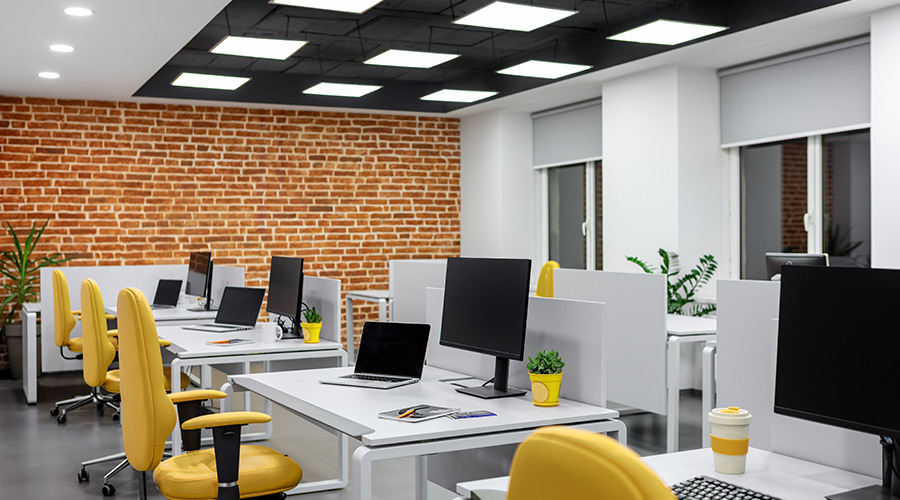Sustainable Design, Flexibility, Mobility Are Key Selection Criteria for Office Furniture
The office furniture market is in a state of rapid change. Shifts in the way employees work are prompting developments in workplace design that facility managers who are in the market for office furniture will want to consider, says Andrew Laing, director, North America, with design firm DEGW. "What's driving furniture trends is what's happening with the way people are working: how they're working and using space differently."
Twenty to 30 years ago, cubicles largely replaced what were referred to as "bullpen offices," featuring rows of desks, with no walls or panels to separate them, says Tom Reardon, executive director of the Business and Institutional Furniture Manufacturer's Association (BIFMA). Employees enjoyed little, if any, privacy.
Bullpen layouts gradually gave way to cubicles, whose panels offered several benefits, Reardon says. For starters, they offered workers some privacy. "A cubicle was a transition to a private office. They provided some visual and acoustical privacy," Reardon says. In addition, they provided a way to bring power to technical tools, including phones and personal computers, that were becoming ubiquitous across many workplaces, he adds.
Today, a new round of changes is well underway. As a starting point, employees' increasing mobility is affecting both the design and allocation of space within buildings. More employees work remotely, at least part of the time. In fact, some companies that have surveyed their workplaces have found that, on any day, a high percentage of workstations go unoccupied, says Dianne Dunnell, senior interior designer with Margulies Perruzzi Architects. To use both space and their facilities budgets more efficiently, more organizations expect employees to share desks or work stations. There's no need to provide a workstation with full panels and storage for an employee who may be in the office infrequently.
After all, costs are a significant concern in any discussion of office design and furniture. Real estate is a significant expense, and companies looking to cut costs often zero in on this budget item. Many organizations, particularly given the tight economy, have shown a preference for less tailored, less expensive furniture.
Focus on Simpler Systems
In addition, today's technical tools are smaller and simpler than they were a decade ago, Reardon says. Flat screens are replacing bulky monitors, and laptops increasingly can take the place of desktop computers. "Technology is making a need for simpler furniture," he says.
"Clients are expecting less costly, less elaborate systems that they can more easily manage themselves," Laing says. In some cases, they've redirected some of these funds to greater spending on collaboration spaces.
A focus on cost, as well as less need for large areas for individual workers, has contributed to the drop in the size of many employees' workspaces. The average size of the workspace of a middle manager dropped from 151 square feet in 1994 to 120 square feet in 2010, according to a 2010 report by the International Facility Management Association (IFMA).
Moreover, when employees are in the office, many are working in teams or groups, rather than individually. "The work place is becoming more geared to collaborative, interactive work, versus individual work," Laing says. The furniture and design need to support this shift. That may mean fewer individual desks, and greater use of benching systems, meeting tables and soft seating areas. Panels between desks often are either lower or eliminated altogether.
In fact, some organizations have begun deploying "wheelies" or mobile file cabinets that also act as docking stations, Dunnell says. Employees reporting to work in the morning sign out a wheelie, bring it with them to a workstation and then return it at the end of the day. Anything they need to store for the day — say, a purse or a computer bag — may go either in the wheelie or a locker.
As more workspaces are shared between employees, the furniture within them will need to accommodate workers of different heights and builds. Adjustable pieces are helping organizations meet this objective, Laing says.
In addition, while the paperless office isn't yet the norm, more organizations are trying to store documents electronically, rather than hang onto hard copies, says Jane Sullivan, senior interior designer with Margulies Perruzzi. "They definitely want to ditch the paper," she says. That's led to a reduction in storage areas within employees' workspaces, although some organizations are making greater use of common file areas.
Similar shifts are occurring in other types of facilities, such as universities, Laing says. More professors are asking students to work on projects in groups, while students are taking advantage of mobile technology to study just about anywhere. "The furniture has to respond to that," he says.
Even as tools become more mobile, most still require a source of power, at least some of the time. And "no one finds it acceptable to crawl on the floor to plug equipment in," Laing says. Instead, facility managers should develop a system to transmit power to areas in ways that look clean. Almost everyone has been in an office in which lengths of cables are duct-taped to the floor. While that's preferable to leaving them loose and potentially creating a tripping hazard, more organizations are trying to find less intrusive ways to bring power to workstations. In some cases, the desk or workstation itself can be a power source.
Related Topics:














